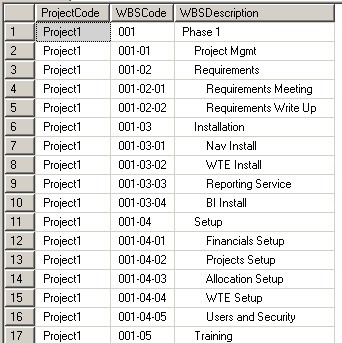Recently, while developing an SSIS package, I came across a scenario where I needed to create parent-child relationships between rows in a relational table. Let’s have a look at some sample data:
Notice the values in the WBSCode column, 001 is the parent of all 001-XX rows, 001-02 is the parent of all 001-02-XX rows and so on. We need to create a relationship by populating the ParentID field so that the resulting structure can be traversed using a recursive CTE. Here’s a code snippet to create some sample data.
--create sample data
Declare @ProjectWBS TABLE
(
ID int IDENTITY(1,1) NOT NULL Primary Key,
ProjectCode varchar(20) NULL,
WBSCode varchar(100) NULL,
WBSDescription varchar(max) NULL,
ParentID int NULL
)
INSERT @ProjectWBS (ProjectCode, WBSCode, WBSDescription, ParentID)
Select 'Project1', '001', 'Phase 1', NULL
union all Select 'Project1', '001-01', 'Project Mgmt', NULL
union all Select 'Project1', '001-02', 'Requirements', NULL
union all Select 'Project1', '001-02-01', 'Requirements Meeting', NULL
union all Select 'Project1', '001-02-02', 'Requirements Write Up', NULL
union all Select 'Project1', '001-03', 'Installation', NULL
union all Select 'Project1', '001-03-01', 'Nav Install', NULL
union all Select 'Project1', '001-03-02', 'WTE Install', NULL
union all Select 'Project1', '001-03-03', 'Reporting Service', NULL
union all Select 'Project1', '001-03-04', 'BI Install', NULL
union all Select 'Project1', '001-04', 'Setup', NULL
union all Select 'Project1', '001-04-01', 'Financials Setup', NULL
union all Select 'Project1', '001-04-02', 'Projects Setup', NULL
union all Select 'Project1', '001-04-03', 'Allocation Setup', NULL
union all Select 'Project1', '001-04-04', 'WTE Setup', NULL
union all Select 'Project1', '001-04-05', 'Users and Security', NULL
union all Select 'Project1', '001-05', 'Training', NULL
union all Select 'Project1', '001-06', 'Testing', NULL
union all Select 'Project1', '001-06-01', 'Financial Testing', NULL
union all Select 'Project1', '001-06-02', 'Project Testing', NULL
union all Select 'Project1', '001-06-03', 'Project Allocation Testing', NULL
union all Select 'Project1', '001-06-04', 'WTE Testing', NULL
union all Select 'Project1', '001-06-05', 'Users and Security Testing', NULL
union all Select 'Project1', '001-07', 'Onsite Go Live', NULL
union all Select 'Project1', '001-08', 'Development', NULL
union all Select 'Project1', '001-08-01', 'Overtime functionality', NULL
union all Select 'Project1', '001-09', 'Data Migration', NULL
union all Select 'Project1', '002', 'Phase 2', NULL
union all Select 'Project1', '002-01', 'Monthly Support', NULL
union all Select 'Project1', '002-01-02', 'Support Training', NULL
union all Select 'Project1', '002-01-03', 'Support Account Mgmt', NULL
--Select * from @ProjectWBS
I started by creating the following function that returns no. of occurrences of a particular character in a given string:
CREATE FUNCTION fnc_CountChar(@string varchar(max), @char char(1) )
RETURNS INT
BEGIN
RETURN (LEN(@string) - LEN(REPLACE(@string, @char, '')))
END
After this, I declared the following CTE:
--create hierarchical structure
;With WBSHierarchy
as
(
Select Parent.ID, Parent.ProjectCode, Parent.WBSCode, Parent.WBSDescription,
0 as Level, null as ParentID, Cast(null as varchar(MAX)) as ParentWBSCode
From @ProjectWBS Parent
Where dbo.fnc_CountChar(Parent.WBSCode, '-') = 0 --no hiphen "-" in parents
union All
Select Child.ID, Child.ProjectCode, Child.WBSCode, Child.WBSDescription,
Parent.Level+1, Parent.ID as ParentID, Cast(Parent.WBSCode as varchar(max)) as ParentWBSCode
From @ProjectWBS Child
inner join WBSHierarchy Parent on Child.WBSCode Like Parent.WBSCode + '-%' -- childWBS = parentWBS-xx
and dbo.fnc_CountChar(Child.WBSCode, '-') = Parent.Level + 1 --childs should have only one hiphen more than their parent
)
--Select * from WBSHierarchy order by WBSCode
Notice that in the above CTE definition, I considered all rows with single occurrence of “-” as the parent rows. Then, I used the fact that ChildWBS=ParentWBS-XX, and the no. of “-” occurrences in child WBS will be equal to one greater than its parent. Here’s the output of the above CTE.
Things were much simple after this, and I was able to write a single update query to populate the ParentID fields of all the rows in the original table as follows:
--update parentID
update @ProjectWBS
set ParentID = H.ParentID
from @ProjectWBS W
inner join WBSHierarchy H on W.ID=H.ID
That’s all. Now the result can be traversed using the following recursive CTE:
--traverse the resulting structure using a recursive CTE
;With WBSHierarchy
As
(
Select Parent.ID, Parent.ProjectCode, Parent.WBSCode, Parent.WBSDescription, 0 as Level
from @ProjectWBS Parent
where Parent.ParentID is null
union all
Select Child.ID, Child.ProjectCode, Child.WBSCode, Child.WBSDescription, Parent.Level+1 as Level
from @ProjectWBS Child
inner join WBSHierarchy Parent on Child.ParentID=Parent.ID
)
Select ProjectCode, WBSCode, space(Level*4)+WBSDescription as WBSDescription
from WBSHierarchy order by WBSCode
Update:
I got a very nice solution from Mitesh in the comments below. He used the fact that if we drop all the characters after the last “-” then we can get the parent WBS, i.e. 001-01-01 can be transformed into 001-01. Great find, Mitesh! Hence, we can do all the transformation without a recursive CTE or UDF like this:
;WITH CTE
AS
(
SELECT
WbsCode,
SUBSTRING(WbsCode,1,LEN(WbsCode)-
CASE
WHEN CHARINDEX('-',REVERSE(WbsCode)) > 0
THEN CHARINDEX('-',REVERSE(WbsCode))
END
) AS EParentID ,
ParentID
FROM
@ProjectWBS
)
UPDATE
C
SET
PARENTID = P.ID
FROM
@ProjectWBS P
INNER JOIN
CTE C
ON
C.EParentID = P.WBSCode
Let me know if you have any other solution to such scenario.




